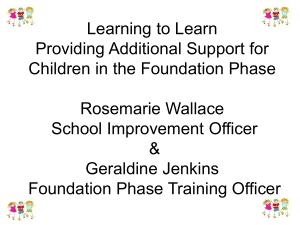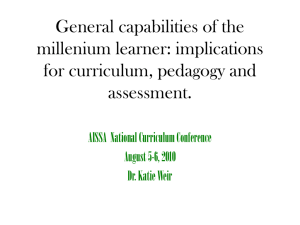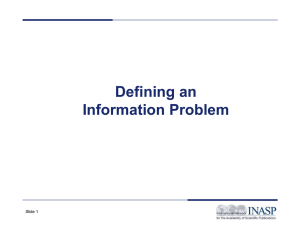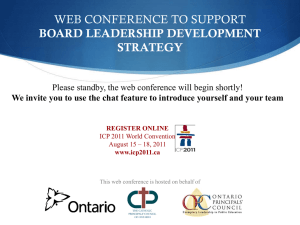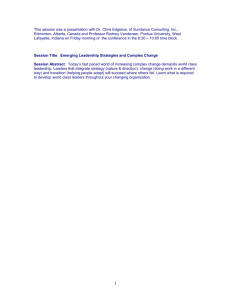Certified Software Tester (CSTE) Proposal
advertisement
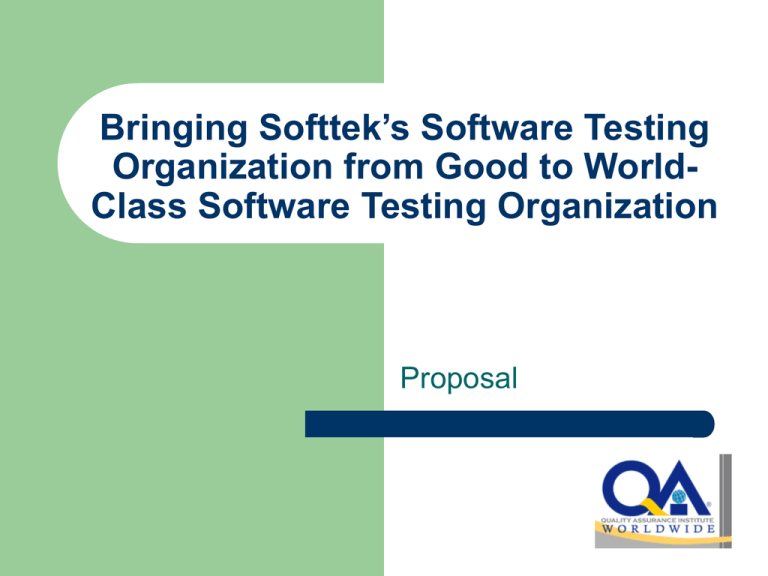
Bringing Softtek’s Software Testing Organization from Good to WorldClass Software Testing Organization Proposal Agenda Mission Statement Vision Statement Goals Assessing Software Testing Capabilities – Your current processes Process to achieve a world-class software testing organization Deployment Process Assessing Software Testing Competencies - The quality of your testers Q&A Mission Statement Mission Statement To bring Softtek’s Software Testing Organization from Good to World-Class Software Testing Organization implementing the Quality Assurance Institute’s (QAI) World-Class Software Testing Model. Vision Statement Vision Statement To be an outsourcing Software Testing Organization leader in providing Quality Control services for our customers. Goals Goals To implement the Quality Assurance Institute’s World-Class Software Testing Organization Model in the organization, to improve Software Testing Capabilities. To implement the Quality Assurance Institute’s developed Common Body Of Knowledge (CBOK) for a Certified Software Tester (CSTE) in the organization, to improve tester’s competencies. To have Software Tester’s certified as CSTE within 1 year. Assessing Software Testing CapabilitiesYour Current Processes Assessing Software Testing Capabilities Most testing organizations, as well as testers, believe they are doing a good job. However, there is no basis for making that determination. In order to make that determination, an assessment must be made against a “model” of a world-class testing organization. During the past 20 years the Quality Assurance Institute has studied many organizations and has developed a model of a world-class testing organization. Assessing Software Testing Capabilities The Nine components needed to achieve WorldClass Software Testing are: – Management Support – Processes – Training – Planning – Quality Control – Tools – Efficiency – Test Execution, analysis and Reporting – User Satisfaction Assessing Software Testing Capabilities – QAI’s Model User Satisfacti on Quality Control Planning Tools/ Techni ques Execution and Reporting Efficiency Processes Training Management Support (Testing Environment) Assessing Software Testing Capabilities Cause-Effect-Diagram Drivers of World-Class Testing Tools Processes Management Support Desired Result Planning WorldClass Testing Test Execution Analysis and Reporting Quality Control Efficiency User satisfaction Training Assessing Software Testing Capabilities User Satisfaction: – To involve the user at key points in the software testing process: Test Strategy Test Objectives Test Plan Acceptance Testing Reporting the status and results of testing Assessing Software Testing Capabilities Quality Control – It raises the question, “Who tests the testers?” The answer is quality control within the test process evaluates whether the process has been performed correctly. – Assessment to evaluate software testing organization’s competencies. The following test processes incorporate quality control as part of the process: Assessing Software Testing Capabilities – Eleven-step software testing process – Assess Project Management Development Estimate and status – Develop Test Plan – Requirements Phase testing – Design Phase Testing – Program Phase Testing – Execute Test and Record Results Assessing Software Testing Capabilities – – – – – Acceptance Test Report Test Results Testing Software Installation Test Software Changes Evaluate Test Effectiveness Assessing Software Testing Capabilities Testing Specialized Systems and Applications – Testing the Adequacy of System Documentation – Testing Web-based Systems – Testing Off-the-Shelf Software – Testing Security – Creating Test Documentation Assessing Software Testing Capabilities Execution and Reporting – Provides the opportunity to evaluate executable programs as a system Build Test Data Execute Test Record Test Results Test Report Assessing Software Testing Capabilities Planning – If you fail to plan, plan to fail – To plan a test together with the components of a test plan Develop Test Plan Assessing Software Testing Capabilities Efficiency – Involves planning and performing software testing in a manner that provides the greatest coverage and the maximum assessment of business risks for the resources allocated Establishing a Software Testing Methodology Determining Software Testing Techniques Selecting and Installing Software Testing Tools Evaluate Test Effectiveness Assessing Software Testing Capabilities Tools Techniques – Tools are necessary to provide effective and efficient software testing Processes for selecting and installing testing tools Assessing Software Testing Capabilities Processes – Without processing, testing is an art that is subject to significant variation in execution Processes bring stability and consistency to software testing – Building a Software Testing strategy – Eleven –Step Software Testing Process Assessing Software Testing Capabilities Training – Effective software testing begins and ends with education Define the test strategy that must include training 11 step testing process in which software testers must be trained Assessing Software Testing Capabilities Management Support (Test Environment) – Effective testing requires strong management support Support is needed so that the test strategy meets the needs of the business, and appropriate time and resources are available to accomplish that strategy Establish the need for management’s support by providing a baseline of the current software testing capabilities and competencies Process to achieve a world-class software testing organization Process to achieve a World-Class Software Testing Organization A Four step process to achieve a World-Class Software Testing Organization: 1. Use QAI’s model for setting a strategic quality goal 2. Develop a baseline by assessing your current processes 3. Based on the results of the assessment, a long-range strategy will be developed to maximize the efficiency of the organization 4. Define a quick-payback approach to implement the strategy Process to achieve a World-Class Software Testing Organization 1. Use QAI’s model for setting a strategic quality goal User Satisfacti on Quality Control Planning Tools/ Techni ques Execution and Reporting Efficiency Processes Training Management Support (Testing Environment) Process to achieve a World-Class Software Testing Organization 2. Develop a baseline by assessing your current processes 1. Build Assessment Team 2. Complete Assessment Questionnaires 3. Build Kiviatt Chart 4. Assess Results Assessing Current ProcessWorkbench Software testing assessment workbench DO CHECK REWORK Task 1 Build Assessment Team Knowledge of Software Testing Activities Task 2 Complete Assessment Questionnaires Task 3 Build Kiviatt Chart Task 4 Assess Results Assessment Testing performed correctly? Your Status versus a World-Clas Testing Organization Process to achieve a World-Class Software Testing Organization Task 1: Build Assessment Team The assessment team needs to combine people who in totality possess the knowledge on how software testing is performed in your organization Task 2: Complete Assessment Questionnaires It is composed of eight categories (Drivers of World- Class Testing) Task 3: Build Kiviatt Chart This chart is implemented to transcribe the results of completing Questionnaire Process to achieve a World-Class Software Testing Organization Task 4: Assess Results Asses status of each category versus what the category should be in a world-class testing organization Interpret your software testing assessment Kiviatt Chart Task 1: Build Assessment Team Softtek Testing Services Complete Assessment Complete Assessment Complete Assessment Testing Project 1 Lead Testing Project 2 Lead Testing Project 3 Lead Team Member 1 Team Member 2 Team Member 3 Team Member 1 Team Member 2 Team Member 3 Team Member 1 Team Member 2 Team Member 3 Complete Assessment Testing Project 4 Lead Team Member 1 Team Member 2 Team Member 3 Complete Assessment Testing Project 5 Lead Team Member 1 Team Member 2 Team Member 3 Task 2: Assessment Questionnaires Task 3: Kiviat Chart Management Support for Test 5 Test Planning 4 Use of Test Processes 3 2 1 Test Quality Control Test Tools User satisfaction with testg Test Traiining Test Efficiency Task 3: Kiviat Chart For each category the number of Yes responses should be totaled A dot should be placed on the kiviat chart on the line representing the number of Yes responses For example: – If there were three Yes responses for test planning a dot would be placed on the test planning line at the intersection of the line representing three Yes responses. Task 3: Kiviat Chart – – A dot should be put on the line representing all eight categories for the number of Yes responses. The dots are then connected by a line resulting in what is called a “footprint” of the status of your software testing organization versus a world-class testing organization. Task 4: Assess Results Softtek can use the results of this assessment in any of these three ways: 1. Determine Softtek’s current software testing status versus a world-class testing organization. The responses in the area to address will indicate Softtek’s strengths and weaknesses compared to a world-class testing organization 2. Develop a software testing goal to become a world-class testing organization 3. Develop an improvement plan Deployment Process Deployment Process Assessment questionnaires are sent to Test leads Test Leads answer questionnaires Total number of “Yes” are dumped into Capabilities Assess Results Matrix Kiviat Chart is built Based on Results develop testing goals Develop improvement plan Deployment Process Deployment Process Management Support for Test 5 Test Planning 4 Test Processes 3 2 1 Test Quality Control Test Tools 1 User satisfaction Test Training Test Efficiency Deployment Process Interpreting Kiviat Results: – The areas that need improvement are: Test Training Test Efficiency Test Quality Control Assessing The Quality Of Your Testers Assessing the quality of your testers Assessing the Quality of Your Testers – This practice will enable you to assess your individual testing competencies against the five skill categories in QAI’s Common Body of Knowledge (CBOK) General Skills Test Skills/Approaches Test Planning Executing the Test Plan Test Analysis and Reporting Assessing the quality of your testers Test Competency Cause-Effect-Diagram Drivers of Testing Competency Test Analysis/ Reporting Skills Test Planning Skills Desired Result Management Support Fully Competent Tester Test Execution Skills Test Skills/Test Approaches Test Competency Workbench Test Competency assessment workbench DO CHECK REWORK Task 1 Understand CSTE CBOK CSTE Common Body of Knowledge Task 2 Complete Assessment Questionnaires Task 3 Build Kiviatt Chart Task 4 Assess Chart Assessment Testing performed correctly? Your Competency versus CSTE CBOK Assessing the quality of your testers Task 1: Understand CSTE CBOK Before you can effectively evaluate your software test competencies, you need to understand the Common Body Of Knowledge (CBOK) for software testing Task 2: Complete Assessment Questionnaires It is composed of 5 categories (Drivers of Testing Competency) Task 3: Build Kiviat Chart This chart is implemented to transcribe the results of completing Questionnaire World-Class Software Testing Organization Model Task 4: Assess Chart Assess status of each category versus what the category should be as indicated in the CSTE CBOK Interpret your software testing competencies against your current job responsibilities Task 1: Understand CSTE CBOK Task 2: Complete Assessment Task 3: Kiviat Chart General Skills Test Skill/ Approaches Test Planing 20% 40% 60% Test Analysis, Reporting and Ivement 80% 100% Test Execution Task 3: Kiviat Chart For each of the five questionnaires, total the number of Yes responses. Convert the number of Yes responses to a percentage by multiplying the number of Yes responses by 10 (e.g., 3 Yes responses x 10= 30%) Transcribe the percentage for each of the five questionnaires. For the lines corresponding to the questionnaire name, put a dot on the kiviat chart for the percentage of Yes responses for that assessment competency category. Task 4: Assess Chart Any rating less than 100 percent indicates a potential area of improvement in that skill category Interpret your software testing competencies against your current job responsibilities Q&A Any Questions….

